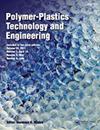Correlation Between Crystallization Behavior and Mechanical Properties of Biodegradable Poly(Caprolactone-co-Cyclohexene Carbonate)
Q2 Materials Science
引用次数: 6
Abstract
ABSTRACT The isothermal and nonisothermal crystallization behaviors of poly(ε-caprolactone) and poly(caprolactone-co-cyclohexene carbonate) were investigated utilizing differential scanning calorimeter and polarized optical microscope. The kinetic of isothermal crystallization could be well defined by Avrami equation, while Mo model was successful to describe the nonisothermal crystallization. Based on the obtained kinetic parameters, poly(cyclohexene carbonate) segments not only act as a nucleating agent accelerating nucleating rate but also restrict the transport of poly(ε-caprolactone) segments decelerating growth rate. The mechanical properties of polymers were investigated using DMA and nanoindentation. It shows that the insertion of hard poly(cyclohexene carbonate) segments improves Young’s modulus and heat resistance but reduces hardness of copolymers. GRAPHICAL ABSTRACT可生物降解聚己内酯-共环己烯碳酸酯结晶行为与力学性能的关系
利用差示扫描量热仪和偏光显微镜研究了聚(ε-己内酯)和聚(己内酯-碳酸共环己烯)的等温和非等温结晶行为。Avrami方程可以很好地定义等温结晶的动力学,而Mo模型可以很好地描述非等温结晶。根据得到的动力学参数,聚碳酸环己烯段不仅作为成核剂加速成核速率,而且还限制聚ε-己内酯段的输运,减缓了聚ε-己内酯段的生长速率。利用DMA和纳米压痕技术研究了聚合物的力学性能。结果表明,硬聚碳酸环己烯段的加入提高了共聚物的杨氏模量和耐热性,但降低了共聚物的硬度。图形抽象
本文章由计算机程序翻译,如有差异,请以英文原文为准。
求助全文
约1分钟内获得全文
求助全文
来源期刊

Polymer-Plastics Technology and Engineering
工程技术-高分子科学
CiteScore
1.71
自引率
0.00%
发文量
0
审稿时长
4 months
 求助内容:
求助内容: 应助结果提醒方式:
应助结果提醒方式:


